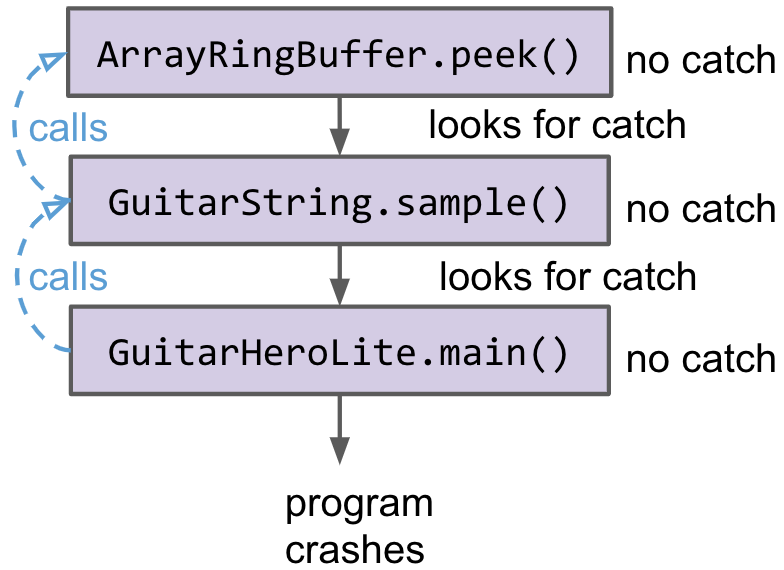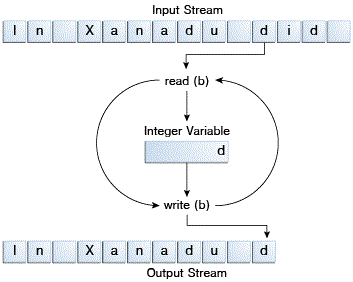3 Exceptions & IO
Exception
- Checked: Must be Caught or Declared to be Thrown(Green One)
- Unchecked: no such restrictions(code below compile just fine)
public class Throwable implements Serializable{
Throwable();
Throwable(String message);//Constructs a new throwable with the specified detail message.
String getMessage();//Returns the detail message string of this throwable
String toString();//Returns a short description of this throwable.
void printStackTrace();
void printStackTrace(PrintStream s);
}
The try-catch mechanism
The try-with-resources Statement
- The try-with-resources statement ensures that each resource is closed at the end of the statement
- The resource can be put here must implements AutoCloseable
//FileReader and BufferedReader are resources
String readFirstLineFromFile(String path) throws IOException {
try (FileReader fr = new FileReader(path);
BufferedReader br = new BufferedReader(fr)) {
return br.readLine();
}
}
When an exception is thrown, it descends the call stack.

In Java SE 7 and later, a single catch block can handle more than one type of exception. This feature can reduce code duplication and lessen the temptation to catch an overly broad exception.
catch (IOException|SQLException ex) {
logger.log(ex);
throw ex;
}
throw and throws
- You can claim to throw an Exception that you really don't
- throws: Anyone call your funcition must catch it or declare to throw this exception.
throw new Exception("Help");//祈使句
public void f()throws SException,IOExption{}//陈述句三单
public void writeList() throws IOException{//IndexOutOfBoundsException is unchecked
PrintWriter out = new PrintWriter(new FileWriter("OutFile.txt"));
for (int i = 0; i < SIZE; i++) {
out.println("Value at: " + i + " = " + list.get(i));
}
out.close();
}
throw Inheritance
成员函数:父类和接口的交集
When you overide a method, you can only throw the exceptions that have beeen specified in the base-class version of the method.
反证: Polymorphism
class A{
void f()throws ExceptionA;
}
class B extends A{
void f()throws ExceptionaA,ExceptionB;
}
void process(A p){
try{
p.f();//Compile过而Run Time error,throw B时A.f()会捕捉不到
}catch(A a){
}
}
process(new B())
构造方法:父类的超集
因为构造方法里隐含调用了 super(); address了父类可以再加自己的
class BaseballException extends Exception{}
class Foul extends BaseballException{}
class Strike extends BaseballException{}
abstract class Inning{
Inning() throws BaseballException{}
abstract void atBat() throws Strike, Foul;
void walk(){}
}
class RainedOut extends Exception{}
class PopFoul extends Foul{}
interface Storm{
void event()throws RainedOut;
}
public class StormInning extends Inning implements Storm{
StormInning() throws RainedOut,BaseballException;
StormInning(String s) throws Foul,BaseballException;
void walk()throws PopFoul{}// Compile Error
void atBat()throws PopFoul{} // call stack, ok
}
IO
Byte Streams
CopyBytes spends most of its time in a simple loop that reads the input stream and writes the output stream, one byte at a time. The best approach is to use character streams

InputStream
- read()
- int read()
- int read(byte b[])
- int read(byte b[],int off,int len): Reads up to len bytes of data from the input stream into an array of bytes. The first byte would be stored into b[off].
- skip(long n)
OutputStream
- write()
- write(int b)
- write(byte b[]);
- write(byte b[],int off,int len)
- flush(): Flushes this output stream and forces any buffered output bytes to be written out
Character Streams
Reader、Writer Method同InputStream/OutputStream
Line-Oriented I/O
BufferedReader: String readLine()
try(
BufferedReader inputStream = new BufferedReader(new FileReader("xanadu.txt"));
PrintWriter outputStream = new PrintWriter(new FileWriter("characteroutput.txt");
) {
while ((String l = inputStream.readLine()) != null) {
outputStream.println(l); // PrintWriter object autoflushes the buffer on every invocation of println or format.
}
}
Character streams are often "wrappers" for byte streams
- FileReader wraps FileInputStream, FileWriter wraps FileOutputStream
- Two general-purpose byte-to-character "bridge" streams: InputStreamReader and OutputStreamWriter
The Standard Streams(System.in, System.out, System.err) are byte streams
//Transform Standard Input/Output into a character stream
BufferedReader br = new BufferedReader(new InputStreamReader(System.in));
BufferedWriter log = new BufferedWriter(new OutputStreamWriter(System.out));
Java.nio
nio = new/Non-blocking IO
- using methods in java.io, threads will block while waiting for a stream or buffer.
- java.nio will not block